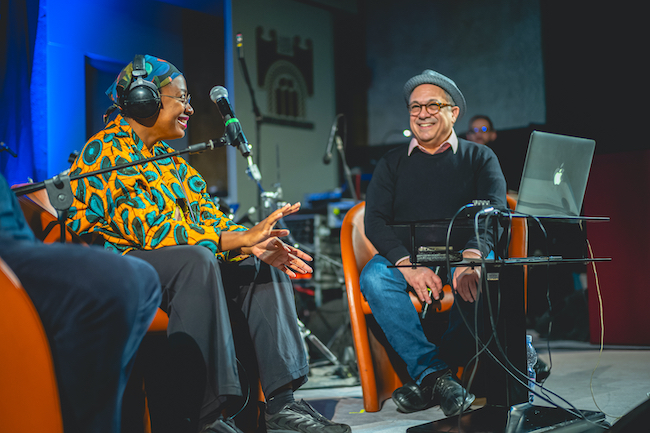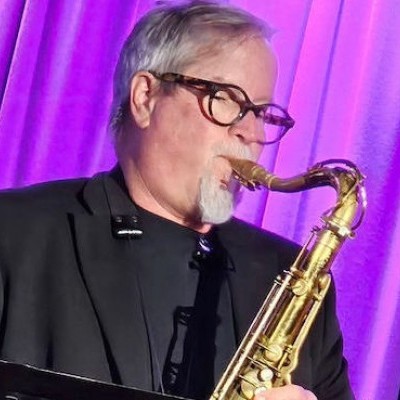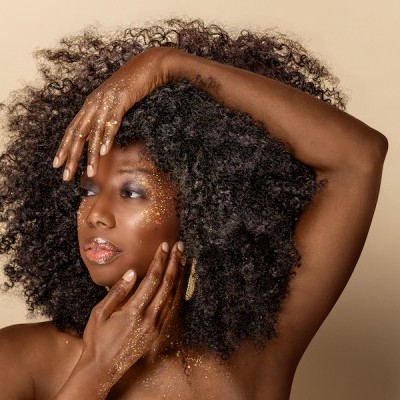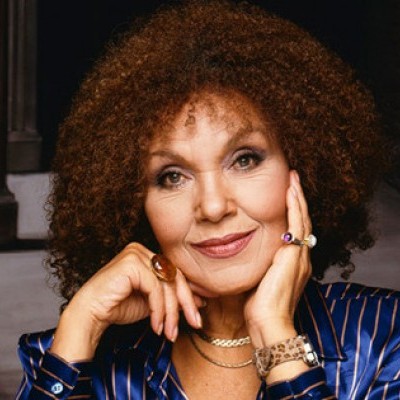Oct 28, 2025 10:47 AM
In Memoriam: Jack DeJohnette, 1942–2025
Jack DeJohnette, a bold and resourceful drummer and NEA Jazz Master who forged a unique vocabulary on the kit over his…

“She reminds me of my childhood and makes we want to cry,” Cécile McLorin Salvant, pictured here with writer Ashley Kahn, said of Dianne Reeves.
(Photo: David Morresi)Italy’s Umbria Jazz Winter is one of those rare annual festivals that not only coincides with a major holiday — climaxing on New Year’s Eve — but also presents its featured artists multiple times at various venues in the small, picturesque town of Orvieto during its five-day span. During the fest’s most recent edition, Cécile McLorin Salvant performed four times with her current quintet of pianist Sullivan Fortner, guitarist Marvin Sewell, bassist Yasushi Nakamura and drummer Keita Ogawa. She also performed with Alexa Tarantino on alto saxophone and flute. On her one day off, she bravely took a chair in front of more than 50 local music fans at the city’s historic Palazzo del Popolo and participated in her first Blindfold Test.
Abbey Lincoln
“Let Up” (Abbey Is Blue, Riverside, 1959) Lincoln, vocals; Tommy Turrentine, trumpet; Julian Priester, trombone; Stanley Turrentine, tenor saxophone; Cedar Walton, piano; Bobby Boswell, bass; Max Roach, drums.
[immediately] This is Abbey Lincoln. This is an album that I’ve listened to a hundred times. I had a teacher in France, Jean-François Bonnel, who brought in a tote bag every class filled with CDs. He wouldn’t say anything, just drop it in front of me. I’d listen to them all. This was one of the first ones I got, so even the intro of the track was very familiar. Abbey was the person who made it attractive to me to write my own songs, share your own personal story, your own poetry.
Anita O’Day
“Them There Eyes” (Anita Sings The Most, Verve, 1957) O’Day, vocals, Oscar Peterson, piano; Herb Ellis, guitar; Ray Brown, bass; Milt Holland, drums.
OK, so this is Anita O’Day. Instantly recognizable tone. The way she scats you know it’s her right away. With Oscar Peterson. She’s just so cool and casual, there’s something very intimate about her voice. Plus she’s very playful. She has a lot of fun with her band. I feel like Oscar Peterson is great — he can really support and accompany singers — but I think she probably counted it off honestly. She feels good, and it’s really swinging.
Lakecia Benjamin
“Mercy” (Phoenix, Whirlwind, 2023) Benjamin, alto saxophone; Dianne Reeves, vocals; Laura Epling, Josée Klein, violins; Nicole Neely, viola; Cremaine Booker, cello; Victor Gould, piano; Ivan Taylor, bass; E.J. Strickland, drums.
Dianne, Dianne, Dianne. Honestly, I think Blindfold Tests for singers must be the easiest. Let’s listen to it. [afterwards] So this is Dianne Reeves. Such a solid beautiful, voice. She is fully in control, technically impeccable. And very emotionally touching. I was brought up in a house where we listened to Billie, Nancy Wilson and Dianne. For me, Dianne is nostalgia more than Anita or Abbey. She reminds me of my childhood and makes me want to cry.
Laufey
“Misty” (YouTube video, 2021) Laufey Lín Jónsdóttir, vocals, guitar.
Oh, this is Laufey. She’s the most famous jazz singer today. I’m very grateful to her because she is bringing a lot of people to this music. I’ve done shows where there are younger people in the audience, maybe in their late teens, and they tell me they know of me through her. Of course, there’s the discourse: “Is it jazz, is it not jazz? What is it?” People will hate, especially if there’s a huge mass of people following someone. But I guess she must be doing something right, and she’s not the first. There’s a group of people in this category like Michael Bublé, Norah Jones, who blew up using some jazz vocabulary. You know, my dad did a Blindfold Test for me and my mom over Christmas. He likes to do this — he’ll just play the intros of songs and we have to figure out the whole song. He tried to catch us with Laufey, but we got him.
Jeanne Lee/Ran Blake
“Night And Day” (Free Standards: Stockholm 1966, Fresh Sound, 1966) Lee, vocals; Blake, piano.
It’s definitely Jeanne Lee and … Mal Waldron? No? OK, Ran Blake. There’s a certain note she sang that gave it away. She wasn’t giving herself away too much in the beginning but then she dug deep, and that’s when I heard it. Her voice is extremely warm but it’s also extremely icy to me, in a good way. This is really adventurous singing and playing and absolutely no pandering. She’s incredible but not very famous, underrated.
Daveed Diggs
“Guns And Ships” (Hamilton: An American Musical (Original Broadway Cast Recording), Atlantic, 2015) Diggs, Leslie Odom Jr., Christopher Jackson, cast, vocals.
We know what this is — Hamilton. Isn’t that the actor with the light skin and curly hair? With Broadway songs and musicals, I love a nice long storyline and I love characters, which is why I love opera, too. I don’t love all musicals or all opera but it’s extremely rich and it’s where I find a lot of songs that I like to cover. So that’s my attraction to it.
Branford Marsalis
“O Solitude” (Braggtown, Marsalis Music, 2006) Marsalis, tenor saxophone; Joey Calderazzo, piano; Eric Revis, bass; Jeff “Tain” Watts, drums.
This is “O Solitude,” but who is this? Branford Marsalis? I’m shocked I got it, actually. I’ve actually heard that track before. Not everybody chooses to play a [Henry] Purcell song. He was an incredible, beautiful Baroque composer who wrote books of songs, set Shakespearian sonnets to music, and a lot of really great vocal music.
Chris Connor
“Lonely Woman” (Free Spirits, Atlantic, 1962) Connor, vocals; Oliver Nelson, Phil Woods, clarinets; Sol Schlinger, bass clarinet; Clark Terry, trumpet; Ronnie Ball, piano; George Duvivier, bass; Ed Shaughnessy, drums.
First of all, it’s an Ornette Coleman song. It’s going to be Julie London … wait, no. Or June Christy. I confuse them a lot — no offense to either of them. But I know that voice, too. Chris Connor? I thought she had a thicker, wider voice than that. This is more about the arranging, and a really unique repertoire choice. It’s beautiful and probably edgy for its time, which I really respect. She’s one of my favorites. She opened the door to that cool style of singing. DB
The “Blindfold Test” is a listening test that challenges the featured artist to discuss and identify the music and musicians who performed on selected recordings. The artist is then asked to rate each tune using a 5-star system. No information is given to the artist prior to the test.

Jack DeJohnette boasted a musical resume that was as long as it was fearsome.
Oct 28, 2025 10:47 AM
Jack DeJohnette, a bold and resourceful drummer and NEA Jazz Master who forged a unique vocabulary on the kit over his…

“I’ve told students, ‘I don’t mind if you use AI for this or that project,’” says MIT’s Pascal Le Boeuf. “‘But you need to tell me.’”
Sep 18, 2025 11:14 AM
A standard joke when it comes to discussing artificial intelligence, or AI, is that it’s developing so rapidly that…

Chuck Manning Works for NASA … and plays jazz.
Sep 18, 2025 11:23 AM
Congratulations! After years of study, you’ve earned your degree in jazz performance. But let’s face it: Making a…

Gadabout Season developed over many months of recording sessions in Brandee Younger’s East Harlem living room.
Sep 16, 2025 11:52 AM
When she’s on the road, Brandee Younger enters a hybrid state of action and contemplation. Free of daily distractions…

Cleo Laine, 1927–2025
Sep 16, 2025 10:03 AM
The music world mourns the loss of three important artists from the realms of jazz, blues and beyond with the recent…